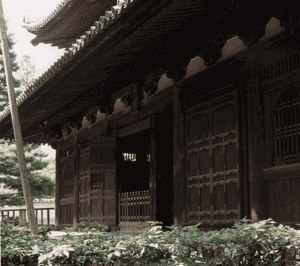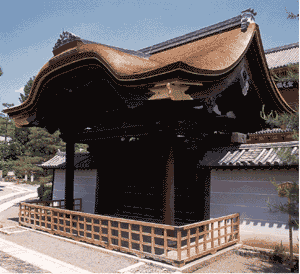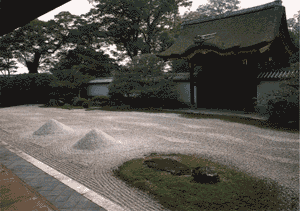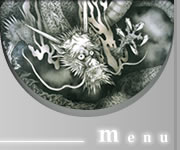Address: 53 Murasakino Daitokuji-cho, Kita-ku, Kyoto-shi, 603-8231 Japan
Tel: 075-491-0019; Fax: 075-491-0016

Daitoku-ji was established in 1315 by Shuho Myocho 宗峰妙超 (1282-1337), more
generally known as Daito Kokushi 大燈國師, with the sponsorship of the emperors Hanazono and Go-Daigo. During this period Daitoku-ji was ranked equally with
Nanzen-ji at the head of the list of Kyoto Five Mountain monasteries, but
after the establishment of the Ashikaga shogunate it removed itself from the
system. During the Onin War many of its buildings were burned; it was
rebuilt by the priest Ikkyu Sojun 一休宗純 (1394-1481) with the support of the
merchants of the port city of Sakai. After the end of the Muromachi period
Daitoku-ji won the support of the military leader Toyotomi Hideyoshi, who
situated the grave of his predecessor, Oda Nobunaga 織田信長 (1534–1582), on the
temple precincts and who also donated land. Daitoku-ji also became a center of
cultural activity through its association with the tea masters Sen no Rikyu
千利休 (1522–1591) and Kobori Enshu 小堀遠州 (1579–1647).
 Daitokuji has a classical Zen monastic layout, with a Sanmon (Mountain
Gate), Butsuden (Buddha Hall), Hatto (Dharma Hall), Hojo (Abbot’s Quarters),
Yokushitsu (Bath House), and Kyozo (Sutra Library). The Hojo is a National
Treasure, as is the Karamon (Chinese Gate), which was moved from Hideyoshi’s
castle in Fushimi, south of Kyoto. The Sanmon, Butsuden, and Hatto are all
Important Cultural Properties. The Chokushimon (Imperial Messenger Gate) was
originally located on the imperial palace grounds. The second story of the
Sanmon, renovated by Sen no Rikyu, contains images of Shakyamuni,
Mahakashyapa, Ananda, and the Sixteen Arhats (a well-known story associated
with the Sanmon is that Rikyu’s installation there of a statue of himself so
angered Hideyoshi that the latter ordered Rikyu to commit ritual suicide in
1481).
Daitokuji has a classical Zen monastic layout, with a Sanmon (Mountain
Gate), Butsuden (Buddha Hall), Hatto (Dharma Hall), Hojo (Abbot’s Quarters),
Yokushitsu (Bath House), and Kyozo (Sutra Library). The Hojo is a National
Treasure, as is the Karamon (Chinese Gate), which was moved from Hideyoshi’s
castle in Fushimi, south of Kyoto. The Sanmon, Butsuden, and Hatto are all
Important Cultural Properties. The Chokushimon (Imperial Messenger Gate) was
originally located on the imperial palace grounds. The second story of the
Sanmon, renovated by Sen no Rikyu, contains images of Shakyamuni,
Mahakashyapa, Ananda, and the Sixteen Arhats (a well-known story associated
with the Sanmon is that Rikyu’s installation there of a statue of himself so
angered Hideyoshi that the latter ordered Rikyu to commit ritual suicide in
1481).
 Daitoku-ji also possesses
numberless cultural treasures in the form of landscape gardens, calligraphy, sliding
screen paintings, hanging scrolls, tea houses, and many implements
associated with the tea ceremony. Many of the finest of these treasures are located in Daitoku-ji’s twenty-two subtemples, among the most important of which are Daisen-in 大仙院, famous for its stone garden; Shinju-an
眞珠庵, the temple of Ikkyu Sojun; and Juko-in 聚光院, the temple most deeply associated with Sen no Rikyu.
Daitoku-ji also possesses
numberless cultural treasures in the form of landscape gardens, calligraphy, sliding
screen paintings, hanging scrolls, tea houses, and many implements
associated with the tea ceremony. Many of the finest of these treasures are located in Daitoku-ji’s twenty-two subtemples, among the most important of which are Daisen-in 大仙院, famous for its stone garden; Shinju-an
眞珠庵, the temple of Ikkyu Sojun; and Juko-in 聚光院, the temple most deeply associated with Sen no Rikyu.


 Daitoku-ji was established in 1315 by Shuho Myocho 宗峰妙超 (1282-1337), more
generally known as Daito Kokushi 大燈國師, with the sponsorship of the emperors Hanazono and Go-Daigo. During this period Daitoku-ji was ranked equally with
Nanzen-ji at the head of the list of Kyoto Five Mountain monasteries, but
after the establishment of the Ashikaga shogunate it removed itself from the
system. During the Onin War many of its buildings were burned; it was
rebuilt by the priest Ikkyu Sojun 一休宗純 (1394-1481) with the support of the
merchants of the port city of Sakai. After the end of the Muromachi period
Daitoku-ji won the support of the military leader Toyotomi Hideyoshi, who
situated the grave of his predecessor, Oda Nobunaga 織田信長 (1534–1582), on the
temple precincts and who also donated land. Daitoku-ji also became a center of
cultural activity through its association with the tea masters Sen no Rikyu
千利休 (1522–1591) and Kobori Enshu 小堀遠州 (1579–1647).
Daitoku-ji was established in 1315 by Shuho Myocho 宗峰妙超 (1282-1337), more
generally known as Daito Kokushi 大燈國師, with the sponsorship of the emperors Hanazono and Go-Daigo. During this period Daitoku-ji was ranked equally with
Nanzen-ji at the head of the list of Kyoto Five Mountain monasteries, but
after the establishment of the Ashikaga shogunate it removed itself from the
system. During the Onin War many of its buildings were burned; it was
rebuilt by the priest Ikkyu Sojun 一休宗純 (1394-1481) with the support of the
merchants of the port city of Sakai. After the end of the Muromachi period
Daitoku-ji won the support of the military leader Toyotomi Hideyoshi, who
situated the grave of his predecessor, Oda Nobunaga 織田信長 (1534–1582), on the
temple precincts and who also donated land. Daitoku-ji also became a center of
cultural activity through its association with the tea masters Sen no Rikyu
千利休 (1522–1591) and Kobori Enshu 小堀遠州 (1579–1647).
 Daitokuji has a classical Zen monastic layout, with a Sanmon (Mountain
Gate), Butsuden (Buddha Hall), Hatto (Dharma Hall), Hojo (Abbot’s Quarters),
Yokushitsu (Bath House), and Kyozo (Sutra Library). The Hojo is a National
Treasure, as is the Karamon (Chinese Gate), which was moved from Hideyoshi’s
castle in Fushimi, south of Kyoto. The Sanmon, Butsuden, and Hatto are all
Important Cultural Properties. The Chokushimon (Imperial Messenger Gate) was
originally located on the imperial palace grounds. The second story of the
Sanmon, renovated by Sen no Rikyu, contains images of Shakyamuni,
Mahakashyapa, Ananda, and the Sixteen Arhats (a well-known story associated
with the Sanmon is that Rikyu’s installation there of a statue of himself so
angered Hideyoshi that the latter ordered Rikyu to commit ritual suicide in
1481).
Daitokuji has a classical Zen monastic layout, with a Sanmon (Mountain
Gate), Butsuden (Buddha Hall), Hatto (Dharma Hall), Hojo (Abbot’s Quarters),
Yokushitsu (Bath House), and Kyozo (Sutra Library). The Hojo is a National
Treasure, as is the Karamon (Chinese Gate), which was moved from Hideyoshi’s
castle in Fushimi, south of Kyoto. The Sanmon, Butsuden, and Hatto are all
Important Cultural Properties. The Chokushimon (Imperial Messenger Gate) was
originally located on the imperial palace grounds. The second story of the
Sanmon, renovated by Sen no Rikyu, contains images of Shakyamuni,
Mahakashyapa, Ananda, and the Sixteen Arhats (a well-known story associated
with the Sanmon is that Rikyu’s installation there of a statue of himself so
angered Hideyoshi that the latter ordered Rikyu to commit ritual suicide in
1481). Daitoku-ji also possesses
numberless cultural treasures in the form of landscape gardens, calligraphy, sliding
screen paintings, hanging scrolls, tea houses, and many implements
associated with the tea ceremony. Many of the finest of these treasures are located in Daitoku-ji’s twenty-two subtemples, among the most important of which are Daisen-in 大仙院, famous for its stone garden; Shinju-an
眞珠庵, the temple of Ikkyu Sojun; and Juko-in 聚光院, the temple most deeply associated with Sen no Rikyu.
Daitoku-ji also possesses
numberless cultural treasures in the form of landscape gardens, calligraphy, sliding
screen paintings, hanging scrolls, tea houses, and many implements
associated with the tea ceremony. Many of the finest of these treasures are located in Daitoku-ji’s twenty-two subtemples, among the most important of which are Daisen-in 大仙院, famous for its stone garden; Shinju-an
眞珠庵, the temple of Ikkyu Sojun; and Juko-in 聚光院, the temple most deeply associated with Sen no Rikyu.